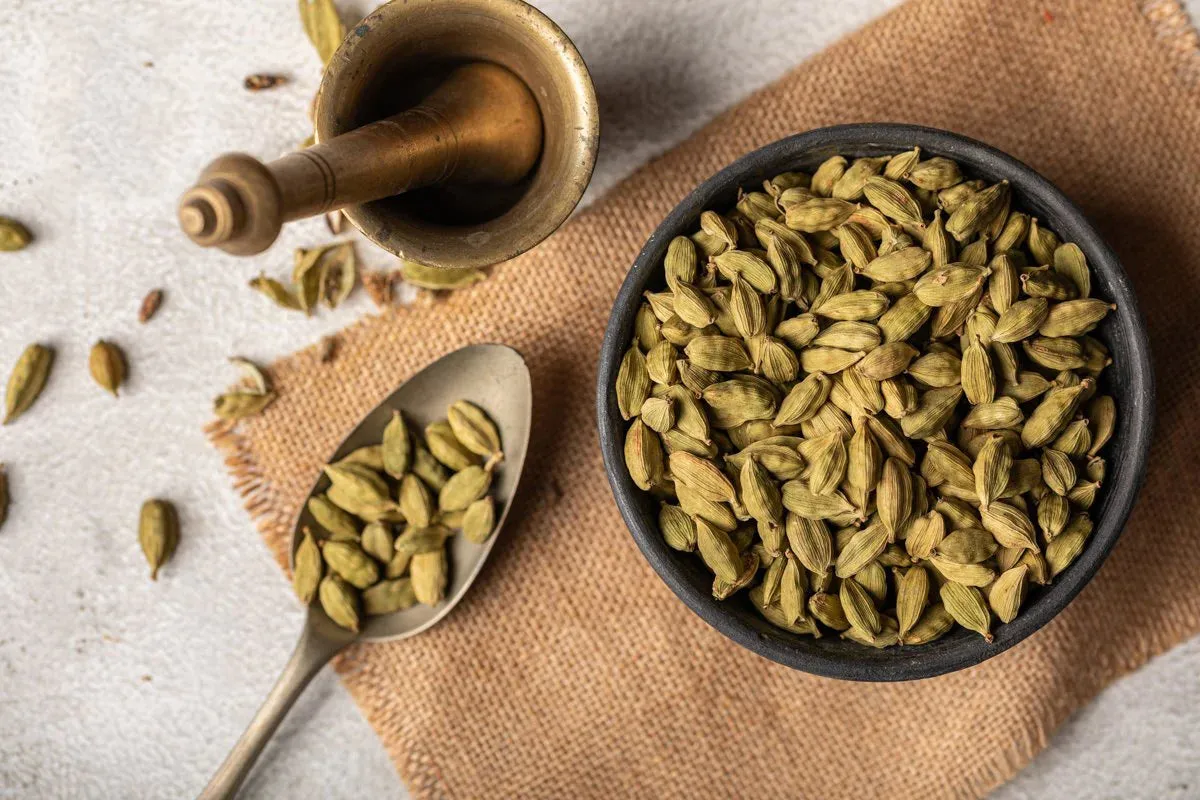Big Cardamom Hits USD 22/kg: Inside India’s 70% Crop Loss and Ethiopia, Bhutan, and Sikkim Role in Global Market!
Cardamom remains one of the world’s most prized spices, celebrated for its unique flavor, health benefits, and indispensable role in both traditional and modern cuisines. In 2025, the global cardamom market is being shaped by weather disruptions, evolving consumer trends, and dynamic shifts in production and trade. This comprehensive report delves into the latest market updates, global production status, key exporters and importers, product quality and harvest timing, current prices with future trends, and essential market signals. We also integrate broader global spice trends discussed during a recent webinar to provide additional context and insights.

1. Latest Market Updates & News
Domestic Market Dynamics in India
- Supply Shortages & Price Stability:
India, a major producer of big cardamom (scissor cut), has experienced significant production setbacks due to adverse weather. Heavy rains and floods in Assam, Meghalaya, and other northeastern states have resulted in 60–70% crop losses during the first harvest, with the second crop also expected to be below normal. This supply crunch has kept domestic prices firm. Currently, big cardamom is trading between USD 22.08–22.20 per kg on the spot market, while auction prices recently ranged from USD 18.61 to 22.80 per kg. In wholesale markets, scissor-cut cardamom is priced between USD 21.85 and 21.98 per kg.
- Export Performance:
Despite production challenges, export demand remains robust. India exported 659.68 tonnes of big cardamom in the first half of the 2024–25 financial year, generating approximately USD 12.18 million. This marks a substantial increase from the previous year’s 458.15 tonnes valued at USD 4.65 million. However, limited domestic availability and low auction arrivals have led farmers and traders to hold back stocks, anticipating further price increases.

Global Cardamom & Spice Market Trends
During a recent webinar titled “Global Spice and Seasoning Market: Trends, Opportunities, and Strategies for Success” hosted by Tridge, industry experts analyzed the rapid global demand for authentic, sustainably sourced spices. Key highlights include:
- Market Valuation & Growth:
The global spices and seasonings market was valued at USD 24.84 billion in 2023 and is expected to grow at a CAGR of 5.25% through 2032. Organic spice sales have grown by over 12% annually, while functional spices like turmeric have seen a 10% annual increase in consumption.
- Consumer Trends:
Consumers are increasingly seeking clean-label, natural, and ethically sourced spices. Ethnic and fusion flavors—incorporating spices such as cumin, cardamom, and za'atar—are gaining traction, particularly in North America and Europe.
- Technological Advancements & Sustainability:
Digital tools like blockchain and data analytics are being employed to enhance traceability and supply chain transparency. These innovations are critical in addressing regulatory challenges, such as the EU’s stringent ethylene oxide limits, which have impacted spice exports from India by contributing to a 20% decline.
- Global Sourcing & Production Shifts:
While India remains a major player in spice exports, countries like Vietnam, Indonesia, Türkiye, and Ethiopia are emerging as significant contributors. In Africa, Ethiopia is particularly notable for its high-value organic spices, including cardamom, driven by its proximity to key markets in Europe and the Middle East.

2. Global Production Status
India
- Production Challenges:
India's cardamom growers have faced substantial losses—up to 70% in the first crop—due to unpredictable weather, flooding, and pest attacks. These challenges have tightened domestic supplies, contributing to sustained high prices.
- Harvest Timing:
Cardamom harvesting typically occurs in two phases. Recent reports indicate that auction volumes have been lower than usual, further tightening the market.
Nepal, Bhutan, & Sikkim
- Regional Production Declines:
In Nepal, daily arrivals range between 500 and 1,000 bags; however, high import duties are restricting trade volumes. Bhutan and Sikkim have similarly reported significant crop losses, adding to regional supply challenges.
Ethiopia & Other Emerging Producers
- Ethiopia’s Potential:
Although political instability in Ethiopia has led to an 8% decline in overall spice exports, the country remains a major producer of high-quality cardamom and other organic spices. Its strategic location enables access to European and Middle Eastern markets.
3. Key Exporters & Importers
Exporters
- India:
The primary exporter of big cardamom, with exports increasing markedly despite domestic production challenges.
- Nepal, Bhutan, & Sikkim:
Smaller volumes from these regions contribute to the overall supply, though they are hampered by high import costs and adverse weather conditions.
- Emerging Players:
Ethiopia and Türkiye are stepping up their production and export capabilities, offering competitive quality and sustainable sourcing practices.
Importers
- Europe:
European countries, particularly Italy, Germany, and France, remain significant importers. Italy, with its robust confectionery and food processing industries, is a major buyer.
- Middle East & North America:
These regions continue to exhibit strong demand for high-quality, sustainably sourced cardamom, driving steady import volumes.

4. Product Quality, Harvest Time, & Quality Factors
Product Quality
- Big Cardamom (Scissor Cut):
Known for its distinct aroma, flavor, and slightly larger size, big cardamom quality is a critical factor. However, the 2024 harvest experienced higher rejection rates due to quality issues, intensifying the price differentiation between premium and lower-grade products.
- Quality Control Measures:
Enhanced post-harvest handling and improved drying techniques are being adopted to preserve kernel quality and reduce moisture content, thereby maintaining higher market standards.

Harvest Timing & Quality Concerns
- India:
The primary harvest occurs in two phases, with the first crop suffering due to heavy rains and flooding. The second crop, though slightly better, still faces challenges from high temperatures and pest pressures.
- Regional Variations:
Similar harvest timings are observed in Nepal, Bhutan, and Sikkim, with weather-induced quality variations impacting overall yields and market prices.
5. Current Prices & Future Trends
Current Price Environment
- Auction & Spot Market Prices:
- Auction prices for big cardamom currently range from USD 18.61 to 22.80 per kg.
- Wholesale market prices for scissor-cut cardamom are observed between USD 21.85 and 21.98 per kg.
- Export Pricing:
Despite fluctuating auction prices, strong export demand has supported upward trends. India’s export performance has significantly improved, with export values rising from USD 4.65 million to approximately USD 12.18 million in the first half of the financial year.

Future Price Trends & Market Outlook
- Supply-Demand Dynamics:
With production severely impacted by adverse weather, supply shortages are expected to persist. If demand remains strong both domestically and internationally, prices are likely to hold firm or even increase.
- Market Signals:
Sellers are strategically withholding stock in anticipation of further price hikes. However, potential TMO interventions—expected around March or April—could inject additional supply and temporarily stabilize prices.
- Global Influences:
Broader market trends in the global spices and seasonings sector, including rising consumer demand for sustainably sourced and organic products, will continue to support premium pricing for high-quality cardamom.

6. Market Analysis & Signals
- Production Disruptions & Supply Shortages:
Significant crop losses in India due to heavy rains and flooding have resulted in limited domestic availability. This constrained supply is a primary driver of the current high price levels.
- Export Growth Despite Domestic Challenges:
India’s export volumes have risen sharply, indicating robust international demand. The increase from 458.15 tonnes to 659.68 tonnes in exports underscores the market’s resilience.
- Competitive Regional Dynamics:
Lower production in neighboring regions such as Nepal, Bhutan, and Sikkim further restricts global supply, while emerging producers like Ethiopia aim to capture greater market share despite facing their own challenges.
- Sustainability & Traceability Trends:
As discussed during the global spices webinar, the adoption of digital tools for supply chain transparency is critical. Traceability, sustainable sourcing, and ethical practices are increasingly influencing buyer preferences, particularly in premium markets.
- Economic & Regulatory Factors:
Fluctuations in auction volumes, potential TMO stock releases, and macroeconomic indicators—such as inflation and financing costs—are key signals that traders and buyers are monitoring closely.

7. Additional & Complementary Updates
In addition to the detailed analysis above, several complementary insights and data points from the broader global spice and seasoning landscape enrich our understanding of the cardamom market:
- Webinar Insights on Global Spice Trends:
- The recent Tridge webinar, “Global Spice and Seasoning Market: Trends, Opportunities, and Strategies for Success,” highlighted the rising global demand for exotic spices driven by health, sustainability, and culinary innovation.
- The global spice market, valued at USD 24.84 billion in 2023, is expected to grow at a CAGR of 5.25% through 2032, with organic spice sales increasing by over 12% annually.
- Ethnic and fusion flavor trends are reshaping demand, with spices like turmeric, ginger, and garlic leading the way, alongside niche products that cater to specialized dietary preferences.
- Country of Origin & Regional Analysis:
- Countries such as Japan, Italy, and the UK prioritize domestic spice production, whereas the US and Australia rely on a mix of local and imported supplies.
- South Korea and France emphasize high-quality, locally sourced spices complemented by imported varieties, ensuring a diverse and resilient market supply.
- Sustainability & Regulatory Challenges:
- The EU’s strict ethylene oxide limits and extremely low maximum residue limits (MRLs) have significantly affected Indian spice exports. The Federation of Indian Spice Stakeholders (FISS) warns of a potential 40% reduction in exports by the end of fiscal year 2025.
- Climate change, including droughts in Brazil and supply chain disruptions in Guatemala, continues to challenge producers globally, further emphasizing the need for sustainable farming practices and advanced traceability solutions.
- Emerging Regional Opportunities:
- Rising incomes and a growing middle class in the Asia-Pacific region, as well as increasing demand in the Middle East and Africa, present significant opportunities for cardamom and other spices.
- E-commerce is transforming the spice market, with online sales growing at 15% annually, enabling smallholder producers from Sub-Saharan Africa and Southeast Asia to access global markets.
- Other Spice Developments:
- In Karnataka’s Chamarajanagar district, turmeric acreage is expected to increase by 10 to 15% this year due to favorable pre-monsoon rains and the introduction of high-yielding varieties.
- Noteworthy products, such as Germany’s TOMAMI Toscana Spice Sauce—a niche liquid seasoning—underscore the innovation and premium positioning within the global spice category.
Final Thoughts
The cardamom market in 2025 is at a critical juncture, defined by severe production challenges in India, strong export demand, and dynamic global trends in the broader spice industry. Key takeaways include:
- Short-Term Outlook:
Continued supply shortages, driven by adverse weather and reduced production in India, are likely to keep prices firm. Strategic stockholding by sellers and robust export growth further support high price levels.
- Long-Term Trends:
Emerging production from countries like Ethiopia and increasing digital traceability efforts will shape the future market. Global consumer trends toward sustainable, organic, and ethically sourced spices will continue to bolster premium products.
- Market Signals:
Traders and buyers should closely monitor auction trends, TMO interventions, weather conditions, and regulatory developments, all of which will play decisive roles in the market’s evolution.
As stakeholders navigate this complex environment, leveraging real-time market intelligence and sustainable sourcing strategies will be key to maintaining competitiveness and capitalizing on emerging opportunities in the global cardamom and spice market.
Frequently Asked Questions
FAQ 1: Why Are Big Cardamom Prices So High in 2025?
Prices have surged due to adverse weather conditions causing up to 70% crop losses in India’s main cardamom-growing regions. Reduced supply, combined with strong domestic and export demand, has kept prices elevated.
FAQ 2: Which Countries Lead the Global Cardamom Market?
India remains a top producer and exporter of big cardamom. Nepal, Bhutan, and Sikkim also contribute, though they face weather and logistical challenges. Ethiopia is emerging as a key producer, while the Middle East and Europe are among the largest importers.
FAQ 3: How Have India’s Cardamom Exports Performed Recently?
India exported 659.68 tonnes of big cardamom in the first half of the 2024–25 financial year, valued at USD 12.18 million—a notable jump from the 458.15 tonnes (USD 4.65 million) exported in the same period last year.
FAQ 4: What Is Scissor-Cut Cardamom, and Why Is It Popular?
Scissor-cut refers to a processing method that trims cardamom pods for a cleaner appearance and more uniform product. Buyers value it for consistent quality and ease of use, which often commands a higher price.
FAQ 5: When Is the Cardamom Harvest Season?
Cardamom is typically harvested in two phases. In India, the first phase can coincide with monsoon rains (leading to significant crop risk), while the second harvest occurs later in the year but may also face high-temperature or pest-related issues.
FAQ 6: Are Extreme Weather Events Impacting Global Cardamom Supplies?
Yes. Heavy rains and flooding in India’s northeastern states caused major crop damage, while other regions like Nepal, Bhutan, and Sikkim have also reported losses. These conditions limit supply, pushing up prices worldwide.
FAQ 7: What Trends Are Shaping the Cardamom Market in 2025?
Key trends include sustainability requirements, consumer demand for organic spices, and the influence of digital traceability tools. Increased e-commerce adoption is also boosting cardamom sales globally.
FAQ 8: Will Cardamom Prices Decrease Anytime Soon?
Prices depend on multiple factors—crop recovery, weather patterns, and international demand. If crop yields improve in upcoming harvests, or if major exporters release additional stocks, prices may stabilize or decline.
FAQ 9: How Does Cardamom Fit Into the Global Spice Boom?
Cardamom is among the exotic spices gaining popularity due to clean-label and health-focused consumer trends. It aligns with broader market growth seen in spices like turmeric, cinnamon, and ginger, as highlighted in recent global spice market webinars.
This comprehensive report, enriched with insights from global webinars and regional analyses, provides a clear roadmap for understanding the current state and future potential of the cardamom market in 2025.



